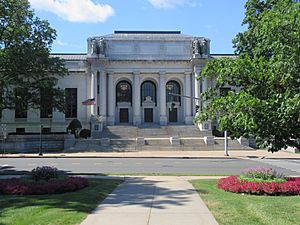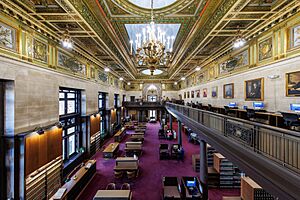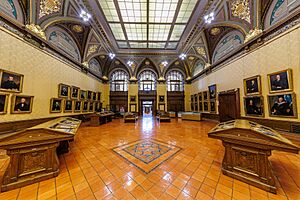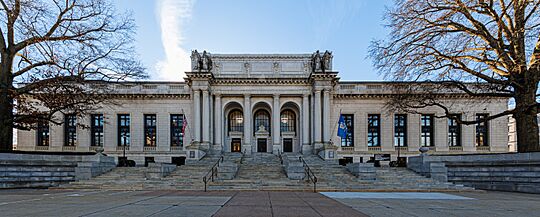Connecticut State Library facts for kids
Quick facts for kids Connecticut State Library |
|
|---|---|
 |
|
| Connecticut State Library & Supreme Court Building | |
| Established | 1854 |
| Location | 231 Capitol Avenue Hartford, CT 06106 |
| Coordinates | 41°45′44″N 72°40′59″W / 41.762316°N 72.683143°W |
| Other information | |
| Director | Deborah Schander (2021–present) |
The Connecticut State Library is a very important library for the state of Connecticut. It's also a part of the state government. You can find it in Hartford, right across from the Connecticut State Capitol building. This library offers many services. It helps people in Connecticut, as well as state workers and officials. Students, researchers, and even other public libraries use its resources. The State Library also helps improve library services across the whole state. Its main goal is to keep Connecticut's history safe and easy to find. It also works to make library services better everywhere.
Contents
History of the State Library
The Connecticut State Library started a long time ago. It was created by the Connecticut General Assembly in May 1854. James Hammond Trumbull was the very first State Librarian. Since then, only eleven people have held this important job. The library's collections were first kept in different State Houses. Later, they moved to the Capitol building. In 1910, the collections found their permanent home. They moved into the State Library and Supreme Court building in Hartford, where they are still today.
Who are the State Librarians?
Here is a list of the people who have served as State Librarian:
- James H. Trumbull (1854)
- Charles J. Hoadly (1855–1900)
- George S. Godard (1900–1936)
- James Brewster (1936–1956)
- Robert C. Sale (1957–1963)
- Walter Brahm (1964–1975)
- Charles E. Funk Jr. (1975–1979)
- Clarence R. Walters (1980–1986)
- Richard G. Akeroyd (1986–1997)
- Kendall F. Wiggin (1998–2019)
- Deborah Schander (2021–present)
How the State Library is Managed
The Connecticut State Library is part of the Executive Branch of the State of Connecticut government. This means it helps carry out the state's laws. A special group called the State Library Board makes the rules for the library. This Board also chooses the State Librarian. The State Librarian is in charge of running the library every day.
Who is on the State Library Board?
The State Library Board has different members. These members help guide the library's work.
- The Chief Justice of the Supreme Court or someone they choose.
- The Chief Court Administrator or someone they choose.
- The Commissioner of Education or someone they choose.
- Five people chosen by the Governor. One must be an experienced librarian. One must be an experienced archivist (someone who manages historical records). One must be an experienced museum expert.
- One member chosen by the Senate president.
- One member chosen by the Senate minority leader.
- One member chosen by the Speaker of the House of Representatives.
- One member chosen by the House minority leader.
These appointed members serve for the same amount of time as the person who chose them. The State Librarian is the main leader of the Board. The Board is the one who appoints the State Librarian.
What the State Library Does
The State Library Board has many important jobs. They are responsible for:
- Overseeing the State Library with the State Librarian.
- Planning library services for the whole state, except for school libraries.
- Making sure Connecticut gets federal money for public libraries.
- Setting standards for the main public libraries.
- Creating a group to help plan library services.
- Running programs for library services across the state.
- Keeping the state's main law library.
- Providing library services for people who are blind or have disabilities.
- Planning and developing the Connecticut Library Network.
- Giving money to public libraries for building projects.
- Creating and keeping the official state archives (historical records).
- Developing programs for libraries and readers.
- Running the Raymond E. Baldwin Museum of Connecticut History and Heritage.
The State Librarian also manages a program for public records. This program helps decide how state and local government records are kept or thrown away. The State Library Board also approves rules for different library programs. These include rules for keeping state publications. They also approve rules for the "borrowIT CT" program.
Services Offered by the State Library
The State Library helps many different people and other libraries.
Library Services for Everyone
- Connecticut State Archives: This is where historical records from the state government are kept. It has tons of records that show how Connecticut's laws and history have changed over time. These records help us understand the state and its people.
- Digital Projects: The State Library makes old historical items available online. They also put government documents that were created digitally online. This helps people see these items from anywhere.
- Government Information: The library has a huge collection of government documents. These include federal and state publications. They also have materials about public policy.
- History and Genealogy: If you want to learn about Connecticut's past or your family history, this is the place! They have old family trees, local history books, Connecticut newspapers, and records about births, deaths, and marriages.
- Law and Legislation: This is the main law library for the state government. It has many state and federal law books. It also keeps old documents from the Connecticut General Assembly.
- Library for the Blind and Physically Handicapped: This special library helps people who can't read regular books. They lend books and magazines in audio format. They also have Braille books. This service is free for any Connecticut resident who needs it.
- Office of the Public Records Administrator: This office helps state and local governments manage their records. They decide how long records need to be kept. They also supervise when old records that are no longer needed can be legally destroyed. This office also runs the State Records Center. State agencies can store their records there temporarily.
How the State Library Helps Other Libraries
The State Library also has a division that supports public libraries across Connecticut.
- Grants to Public Libraries: They give money to public libraries to help them offer services.
- Public Library Construction Grants: These grants help public libraries build new facilities or improve old ones. This makes sure libraries can meet the needs of their communities.
- Library Services and Technology Act Funds: This money supports statewide programs. It helps the Library for the Blind. It also provides training for library staff. It gives grants to public, school, and college libraries.
- Statistical Information: The State Library collects information about Connecticut's public libraries. They organize and publish this data. This helps libraries plan and improve their services.
Sharing Resources Across the State
- researchIT CT: This is a free online service from the CT State Library. It gives people access to articles from journals, magazines, and newspapers. It's for people who use Connecticut public, K12, and college libraries. You can also download audiobooks and eBooks if you have a valid Connecticut public library card.
- borrowIT CT: This is a program that lets you use your local library card at almost any public library in Connecticut. If you have a valid card from your hometown library, you can borrow books from 192 other libraries in the state!
Museum of Connecticut History
The Museum of Connecticut History is a special part of the State Library. It has a beautiful main hall called Memorial Hall. There are also three other exhibit areas. You can see paintings of Connecticut Governors there. The museum also displays very important historical documents. These include the state's original 1662 Royal Charter and the 1639 Fundamental Orders. The museum focuses on Connecticut's government, military, and industrial history.
Library Locations
The Connecticut State Library has several locations:
- The main State Library and Supreme Court Building is at 231 Capitol Ave., Hartford, Connecticut. This building also houses the State Archives and the Museum of Connecticut History.
- The Middletown Library Service Center is at 786 South Main St., Middletown, Connecticut.
- The Library for the Blind and Physically Handicapped is at 198 West St., Rocky Hill, Connecticut.
- The State Records Center is also at 198 West St., Rocky Hill, Connecticut.
- The State Library Storage Facility is at 75 Van Block Ave., Hartford, Connecticut.
Building Design
The building for the Connecticut State Library and Supreme Court started construction on July 29, 1908. The architects, Donn Barber and E. T. Hapgood, designed it in a style similar to Italian Renaissance buildings. The building has three main parts coming off a central lobby. The State Library is on the left, Memorial Hall is in the middle, and the Supreme Court is on the right. The library staff moved into the new building on November 28, 1910.
Later, in 1969, an addition was built onto the East Wing. This new part added more museum space. It also created more room for library collections and offices. The library building was added to the National Register of Historic Places in 1981. This recognized its beautiful architecture and its importance to Connecticut's history.
See also






